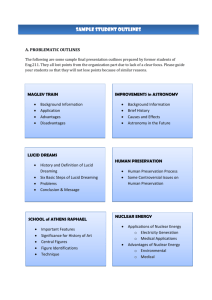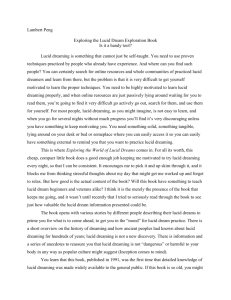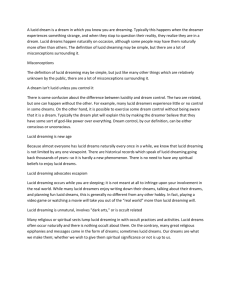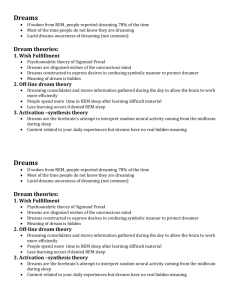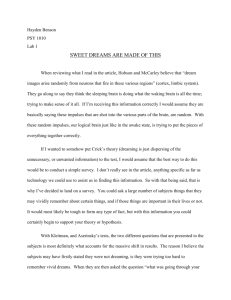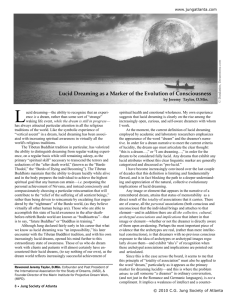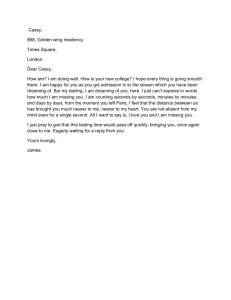Lucid Dreaming and Lucid Surrender
advertisement
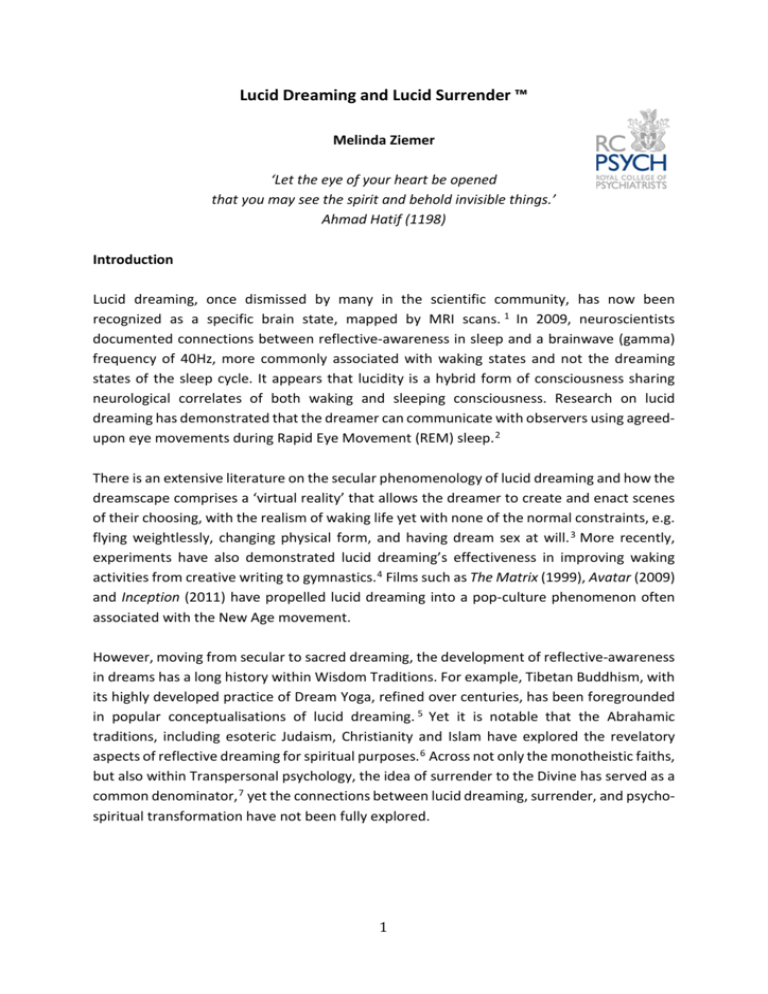
Lucid Dreaming and Lucid Surrender ™ Melinda Ziemer ‘Let the eye of your heart be opened that you may see the spirit and behold invisible things.’ Ahmad Hatif (1198) Introduction Lucid dreaming, once dismissed by many in the scientific community, has now been recognized as a specific brain state, mapped by MRI scans. 1 In 2009, neuroscientists documented connections between reflective-awareness in sleep and a brainwave (gamma) frequency of 40Hz, more commonly associated with waking states and not the dreaming states of the sleep cycle. It appears that lucidity is a hybrid form of consciousness sharing neurological correlates of both waking and sleeping consciousness. Research on lucid dreaming has demonstrated that the dreamer can communicate with observers using agreedupon eye movements during Rapid Eye Movement (REM) sleep. 2 There is an extensive literature on the secular phenomenology of lucid dreaming and how the dreamscape comprises a ‘virtual reality’ that allows the dreamer to create and enact scenes of their choosing, with the realism of waking life yet with none of the normal constraints, e.g. flying weightlessly, changing physical form, and having dream sex at will. 3 More recently, experiments have also demonstrated lucid dreaming’s effectiveness in improving waking activities from creative writing to gymnastics. 4 Films such as The Matrix (1999), Avatar (2009) and Inception (2011) have propelled lucid dreaming into a pop-culture phenomenon often associated with the New Age movement. However, moving from secular to sacred dreaming, the development of reflective-awareness in dreams has a long history within Wisdom Traditions. For example, Tibetan Buddhism, with its highly developed practice of Dream Yoga, refined over centuries, has been foregrounded in popular conceptualisations of lucid dreaming. 5 Yet it is notable that the Abrahamic traditions, including esoteric Judaism, Christianity and Islam have explored the revelatory aspects of reflective dreaming for spiritual purposes. 6 Across not only the monotheistic faiths, but also within Transpersonal psychology, the idea of surrender to the Divine has served as a common denominator, 7 yet the connections between lucid dreaming, surrender, and psychospiritual transformation have not been fully explored. 1 Lucid Surrender Over a number of years, I have found that lucid dreams have theophanic potential. In the lucid state, the dreamer who seeks ‘the essence of existence’ enters the realm of the numinous and sacred, the realm of Divine archetypes, as shown in the following initiatory dream: The dream teacher I go to see in waking life sits down opposite me. As I look up at him, it feels as if a metal band about four inches wide snaps open across my chest. Suddenly, I have the sensation that my being, now free of both dream and physical bodies, hovers in the air over my bed. I remember what my teacher said recently about lucidity: ‘If you’re up out of your body you can fly around and see the world’. But I’ve seen enough of the world in waking life. I want my teacher to guide me to a new experience of lucidity. I call out his name three times. As I do so, a clear, five-pointed star appears in each of my eyes filling me with a powerful light. I think my eyes must be open as white light fills the room, but then I realise I haven’t woken up. When I do awake, my chest hurts. I remain in bed for an hour just taking in the feeling from the lucid dream and recognising that the knowledge for which I yearn is not to be found in earthly science, but rather in ‘spiritual science.’ 8 In lucidity, I am conscious of a relationship between worldly or exoteric knowledge and hidden, esoteric knowledge. Such gnosis feels more received than gained; more an alignment of my will with a Higher Will than knowledge to be used in the interests of my own will. I have named this specific attitude to lucidity Lucid Surrender. In the course of hundreds of dreams of Lucid Surrender, I find my willingness to take the inner stance of surrender has deepened, as reflected back to me by dream-Beings, illustrated in the this example: After a formless lucid dream in which I feel I’ve ‘taken a bath in God’, I find myself deposited in a ‘normal’ dreamscape, on a braided rug before a cottage fireplace. Curled up on the rug, I reflect on the lucid experience as I rest at the feet of a matronly woman who sits rocking in front of the fire. She seems puzzled and almost impatient as she asks me, ‘What kind of lucid dreams are those when you let yourself be taken to God in this way?’ I tell her, ‘Surrender, the Path of Surrender.’ The idea of ‘surrender’ raises the question: ‘To what or to whom do I surrender?’ Essentially one surrenders to the heartfelt recognition that ‘I belong to more than myself.’ Lucid Surrender reflects an inner attitude of heart and mind that not only acknowledges the transpersonal dimension but also expresses a deep longing akin to that sung of by the Psalmist: ‘Like the deer that yearns for running springs, so my soul yearns for you, O God.’ (Psalm 42:1). I find the best way to prepare for dreaming is to quieten my mind and create a 2 heart-centred focus has come through meditation on the Lord’s Prayer, a sacred song or holy name. In my case (reflecting my own faith tradition), I call on the names of Elohim or Jesus, invoked in tandem with the rhythm of the breath before falling asleep. Then, as lucidity emerges in the dream, the alignment of the heart with the Divine Will takes place through simple acts of surrender: a meditative stillness, a head bowed, knees bent in worship, hands brought together in prayer, gestures expressing the longing to know a deeper level of feeling and consciousness. In lucidity, I call out for the esoterically veiled truth to be shown to me. I have often felt surprised to hear myself spontaneously cry out, ‘Take me to you, God!’, a rather more prosaic version of what the 12th century Sufi mystic Ahmad Hatif poetically expressed as: ‘To Thee we surrender both heart and life and cast down both this and that before Thee. The heart is surrendered to Thee, since Thou art the ravisher of hearts….’ 9 The response depends not only on the emotional depth and simplicity of the desire held within the request but also on one’s capacity to ‘hold’ a revelatory experience. What, then, characterises the attitude of Lucid Surrender? 1. A deep yearning for Spirit 2. Courage to take a leap into the mysterious and the unknown 3. Willingness to surrender to irrational and paradoxical aspects of experience with wonderment 4. A heart-centred focus that honours the intuitive mind, marked by an attitude of humility, gratitude and praise rather than ‘the need to know’ 5. Acknowledgement of feelings and a willingness to move through them 6. Trust in a guiding presence, spirit, or quality to call on; over time this becomes internalized 7. Patience to wait while ‘nothing’ happens 8. The capacity to contain awareness of multi-dimensional reality. Developing this capacity and making sense of the experience, takes time and practice. I dream that I find myself in a lecture room where my dream teacher from waking life gives a teaching. Feeling very tired, I fall asleep as I listen, and in my dream-sleep, I become lucid. The dream-within-a-dreamscape parts like a veil and I find myself standing at the edge of a vast hall covered with a fiery-coloured Persian rug. Surprisingly, numerous babies crawl around on the rug like little miracles of light. At the far end of the hall spins a black and white light form that opens up Infinity. I recognise this vision as the deeper space in Lucid Surrender - an expanse of ‘black light’, 3 numinous forms and celestial worlds. Emerging from that black luminosity come spiritual knowledge and Divine love. As I stand observing the scene before me, I simultaneously perceive different dimensions of Being: 1. 2. 3. 4. 5. the mysterious infinity of the abstract, spinning light form the vast hall full of ‘children of light’ in which my lucid-dream-body appears the dream-sleep within the original dream framing the lucid experience the lecture room in which the initial dream took place, and my awareness of myself asleep on the bed In the dream, my awareness of these five levels of consciousness at once strikes me as unusual. As I recognise these dimensions, my dream-body collapses to the floor, the hall dissolves into the black light and, still dreaming, I ‘wake up’ in the lecture room wondering how I must have appeared to those who remained behind. A dream-Being, mimicking my hands’ movements, tells me, ‘You were sitting there in a kind of trance speaking all the time about the how all five dimensions fit together’. 10 Lucid dreaming does not lend itself to a single operational definition. The American Psychological Association (APA) describes it thus: ‘a dream in which the sleeper is aware that he or she is dreaming and may be able to influence the progress of the dream narrative’. This fails, however, to communicate the continuum of consciousness that can be experienced within the lucid state.11 Nor does the APA’s definition convey the transformative effects that lucid dreaming experiences can have upon dreamers in their waking lives. A transpersonal definition of lucid dreaming encompasses a wide range of experience, for instance: ‘a dream in which the sleeper realizes that he or she dreams, thereby releasing the transformative potential to relate to multiple dimensions of Self nested in a greater, unitive consciousness.’ This would include the following potentialities: 1. 2. 3. 4. 5. 6. Extending an ontological status to dreamscapes and dream-Beings Moving perception beyond space-time constraints Revealing more than the dreamer can otherwise know Enabling the dreamer to engage with celestial realms Bringing the dreamer into relationship with the unitive nature of consciousness Expanding and transforming waking consciousness and waking physical reality. Bearing in mind the potentialities within lucidity, we note how Ahmad Hatif’s description of a mystical state reflects the possibilities held within a deeper understanding of lucidity. 4 Describing the opening of ‘the eye of the heart’ that heralds the ‘vision of spirit’ and ‘invisible things’, Hatif advises: Give all that you possess to Love. If your spirit is dissolved in the flames of Love, you will see that Love is the alchemy for spirit…. [y]ou will journey beyond the narrow limitations of time and place and will pass into the infinite spaces of the Divine World….’ 12 In lucidity, I have found that an enlivening reciprocity can take place with a numinous dreamBeing, as in this exchange: Ecstatic black winds carry me a long way. When it feels I have reached the edge of the universe, I become curious about what carries me in such a loving way, and, as previously in lucidity, I yearn to ‘see’ this unseen entity. Suddenly, my ‘head’ feels turned by an invisible hand and I ‘see’ that my Being appears in the embrace of what my mind at first comprehends as an angelic dream-Being of golden, misty, light. This light both holds me and infuses me. I rest in the strange wonder and familiarity of the dream-Being’s light and the feeling of unutterable love between us. It feels as though we have become one. In this way, I share in the dream-Being’s essence, its intelligence and regal nature. Neither the dream-Being’s form, nor my own possess physicality, yet we experience a unity that touches us both with deep joy and ecstatic pleasure. The dream-Being reveals itself to me as fully as I am revealed to it, at once, Lord, Lover and Friend. The mutuality of our awareness of each other as both one and separate suffuses our Beings with pleasure. I become aware this light empowers me for the service I have yet to complete in waking life. Then I think, ‘Where to?’ But it has become hard to breathe. A voice says, ‘Breathe through your mouth.’ I awake breathing hard and deep. Encounters such as these with dream-Beings and numinous landscapes have helped me to understand the teaching of the Hadith: ‘I was a hidden treasure and I longed, I yearned, I loved to be known,’ relating not only to the ‘I’ of our own soul nature but also to the ‘I’ of Absolute Beingness, which too desires to be known. I find that knowledge can come in the lucid state through unvoiced communication - touch, light or breath. The following dream depicts such an experience: After being carried on the ‘black light’ by an unseen presence, my Being is deposited in a still place on the blackness. A man appears, wearing a sky blue cloak and a white cape trimmed with orange over a white inner garment. A single large feather curves up and 5 inwards above his head. He radiates a holy wisdom. I have the sense that he and I should embrace. I feel unworthy of this but obey, opening the energies of my arms and hands. The moment my hands touch this dream-Being’s shoulders and his mine, there erupts a great burst of energy that rushes into me and sends me catapulting back onto the black winds like a feather. I understand that a silent transmission or teaching has taken place, and I realise that the energy in this dream being comes from the same Divine source as the Light I have encountered in other lucid dreams. In this instance, the dream-Being’s touch profoundly communicates ‘Spiritual Science’ comprised of Heart and Will, suffused with a light that illuminates waking reality. Lucid dreams change our lives because they change our realisations, and our perceptions, about life. Through opening ‘the eye of the heart’ and illuminating our ‘inner sight’, such dreams may: 1. 2. 3. 4. Reveal to us how our customary thinking can limit or negatively impact on our souls Free our consciousness from the limits of time-bound and space-bound perception; Bring us spiritual guidance Offer a profound experience of love that spills over into our waking world actions and relationships 5. Enlarge our capacity to hold life’s paradoxes with more equanimity 6. Deepen our feeling capacity and sense of wonder 7. Align our consciousness with a Higher Will, transforming the question ‘Who am I?’ into ‘How can I best serve?’ The theophanic encounter does not end with the dream but is brought to fullness when the qualities of the invisible, celestial sphere - the ‘Divine world’ - are brought into waking reality. In Lucid Surrender, the reality revealed to us through the ‘eye of the heart’ cannot be accounted for simply as a creation of the mind any more than it can be found in the phenomenology of waking reality. I would suggest that our ability to perceive lucid reality originates in the soul’s awareness that ‘I-belong-to-more-than-myself’ rather than in any production of one’s own. When, in the lucid state, we surrender, open our hearts and give all that we possess to Love, we find ourselves taken on a journey beyond the narrow limitations of time and place into the ‘infinite spaces of the Divine World’ where we may ‘see the Spirit and behold invisible things.’ 13 6 References 1 Hobson, Allan J. ‘The Neurobiology of Consciousness: Lucid Dreaming Wakes up.’ The International Journal of Dream Research. Volume 2, No. 2. (2009) Pp 41- 43. LaBerge, Stephen, Lynn Nagel, William C. Dement, and Vincent Zarcone, Jr. ‘Lucid Dreaming Verified by Volitional Communication During REM Sleep.’ Perceptual and Motor Skills 52 (1981): 727 -732. 2 For an introduction to the range of experiences within the lucid state see Stephen LaBerge’s Lucid Dreaming (New York: Tarcher, 1985) and Robert Waggoner’s, Lucid Dreaming Gateway to the Inner Self (Moment Point Press: 2009). 3 As an example of sports psychology in lucid dreaming see the Journal of Sports Sciences, ‘Effectiveness of motor practice in lucid dreams: a comparison with physical and mental practice’ (2015) by Tadas Stumbrys, Daniel Erlacher & Michael Schredl: http://www.tandfonline.com/doi/abs/10.1080/02640414.2015.1030342. 4 A summary of the study can be found in Psychology Today, ‘Lucid Dreaming and the Future of Sports Training’, posted May 08, 2015 by Kelly Bulkeley, Ph.D. on https://www.psychologytoday.com/blog/dreaming-in-the-digital-age/201505/luciddreaming-and-the-future-sports-training. For the connection between creative writing and lucid dreaming see ‘Magic, Meditation and the Void: Creative Dimension of Lucid Dreaming’ by Clare Johnson, Ph.D.’ in Lucid Dreaming: New Perspectives on Consciousness in Sleep, Vol. 2, edited by Kelly Bulkeley & Ryan Hurd. (Santa Barbara, California: Praeger, 2014) 61 – 64. Norbu, C. N. Dream Yoga and the Practice of Natural Light. (Ithaca, New York: Snow Lion Publications, 1992). 5 For a review of revelatory dreaming in Christianity see Morton T. Kelsey’s God, Dreams, and Revelation: A Christian Interpretation of Dreams (Augsburg Fortress: Augsburg Fortress Publishing, 1991, first published 1967). Henri Corbin provides an overview of theophanic dreaming in his Swedenborg and Esoteric Islam: Comparative Spiritual Hermeneutics. Trans. Leonard Fox. (West Chester, PA: Swedenborg Studies, 1995). And, Catherine Shainberg’s Kabbalah and the Power of Dreaming: Awakening the Visionary Life outlines the connection between the Kabbalistic tradition and revelatory dreams. (Rochester, New York: Inner Traditions, 2005). 6 For more on the relationship between Jungian Psychology and lucid dreaming see ‘Lucid Surrender and the Alchemical Coniunctio’ by Melinda Ziemer in Lucid Dreaming: New Perspectives on Consciousness in Sleep, Vol. 2, edited by Kelly Bulkeley & Ryan Hurd. (Santa Barbara, California: Praeger, 2014) 145-166. 7 7 Henri Corbin. Swedenborg and Esoteric Islam: Comparative Spiritual Hermeneutics. Trans. Leonard Fox. (West Chester, PA: Swedenborg Studies, 1995) 103. The term ‘Spiritual Science’ refers to a celestial, subtle knowledge of esoteric, internal understanding of symbols and spiritual reality. 8 Ahmad Hatif. In Essential Sufism. James Fadiman & Robert Frager, eds. (New York: HarperCollins, 1995) 123. 9 For more on dream-sleep states within lucidity see the chapter ‘Shaman's Drum’ in Not for Innocent Ears: Traditions of a Desert Cahuilla Medicine Woman by Ruby Modesto and Guy Mount, published in 1986 by Sweetlight Books, and Dream Yoga and the Practice of Natural Light by Chogyal Namkhai Norbu, edited by Michael Katz. Snow Lion Publications. 10 11 For more on this topic see, Kellogg, E. W. III. ‘The Lucidity Continuum.’ Paper presented at the eighth annual conference of the Lucidity Association, Santa Cruz, June 28, 1992. The paper is available at The Dream Research Institute, London. ‘Research.’ http://www.driccpe.org.uk/portfolio-view/the-lucidity-continuum-ed-kellogg 12 Hatif, 123. 13 Hatif, 123. © Melinda Ziemer 2015 Melinda Ziemer is a transpersonal psychotherapist, co-founder of the Dream research Institute, London (www.driccpe.org.uk/) and former director of the London-based charity Help Counselling Centre (www.helpcounselling.com) 8
